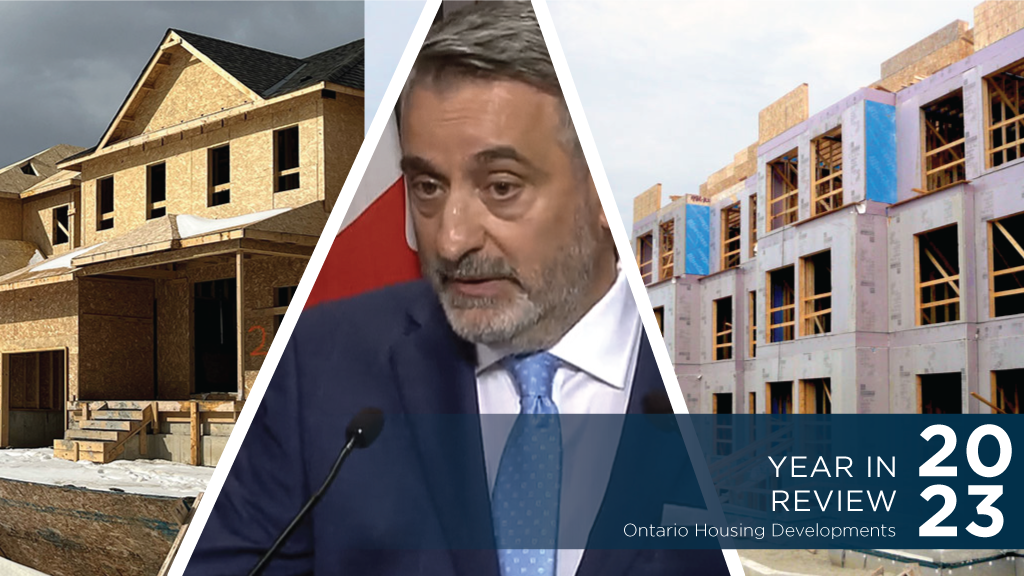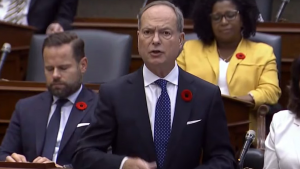Ontario’s housing crisis was a significant newsmaker in 2023 and despite measures, legislation and other initiatives the government rolled out, affordability and availability remained at crisis levels.
The provincial government often cites its commitment to building 1.5 million homes by 2031, but Richard Lyall, president of the Residential Construction Council of Ontario, says what is really needed is participation and buy-in from all levels of government.
“The governments remained unaligned on the housing crisis,” Lyall told the Daily Commercial News.
“The housing situation right now is just going to get a lot worse next year because we are not producing housing that we need…This has been a painful year, next year is going to be harder.
“Something’s got to break somewhere, but we’re not fixing this problem right now at the rate we’re going. Not even close.”
Similarly, Neil Rodgers, interim CEO for the Ontario Home Builders’ Association, said less talk and more action is needed on behalf of the government, starting with getting shovels in the ground.
“We’re still in a period of economic uncertainty with respect to the ability for purchasers to afford housing within their means. We’re also at a point where the cost of financing for builder developers is also up sharply and some of these projects are no longer making the economic sense they might have made a few years ago,” he said. “Builders and developers are putting projects on hold and they are waiting on the sidelines, the same as consumers are for a better economic climate to return.”
Lyall said interest rates and immigration were two big issues in 2023 that directly correlated to the housing dilemma.
“This wasn’t a really busy year on mortgages but the next two or three years is going to be a lot of mortgage resetting. That’s going to really pinch consumers,” he noted.
“We’re looking at declining housing supply with unprecedented population growth, so that only means one thing and that’s not good. The province has had a number of false starts on some things, things that they’ve reversed now. We lost a year there…and that’s not helping things.”
At the Association of Municipalities of Ontario conference in August, in London, Ont., Premier Doug Ford announced the new Building Faster Fund, a three-year, $1.2-billion program that provides new funding based on performance against provincial housing targets.
To expand eligibility, the province also extended its strong mayor powers to municipalities projected to have populations of 50,000 or larger by 2031 that commit to meeting provincial targets.
It’s impossible to talk about housing in Ontario without talking about the Greenbelt scandal that unfolded throughout the year.
Last year, about 15 sites were chosen by the province to be removed from the protected Greenbelt to make way for housing development.
In early September the integrity commissioner’s report was released and Minister of Municipal Affairs and Housing Steve Clark resigned amid the controversy. It found Clark contravened two sections of the Members’ Integrity Act, 1994 “by failing to oversee the process by which lands in the Greenbelt were selected for development.”
A few weeks prior, an auditor general’s report was also released which found Clark’s chief of staff favoured certain developers over others when selecting which lands would come out of the Greenbelt.
Within a few days, new Housing Minister Paul Calandra was appointed and his first order of business was launching a complete review and re-evaluation of Greenbelt development.
In September, Calandra provided an update on the Housing Affordability Task Force. The government fully implemented 21 of the task force’s 74 recommendations but said there was more to be done.
“We fixed a bunch of things that shouldn’t have been problems in the first place like exclusionary zoning,” Lyall pointed out. “Quite a few recommendations have not been acted on like the as of right zoning along avenues, corridors and major streets served by mass transit.”
After months of public outcry, Calandra introduced legislation to return parcels of land to the protected Greenbelt in mid-October.
The following month, he tabled legislation to undo urban and regional boundary expansions which the province had changed including official plans for Barrie, Belleville, Guelph, Hamilton, Ottawa and Peterborough as well as the regional municipalities of Halton, Niagara, Peel, Waterloo and York, and Wellington County.
“This reversal cast significant uncertainty in the legitimate effort and work of landowners, builders, the public and municipalities who invested several years and part of the municipal comprehensive review process related to growth management exercises,” said Rodgers.
“It’s almost back to the drawing board and we have lost critical time in getting lands approved for housing…I don’t believe we are any further ahead in addressing supply than we were years ago.”
In early November, Finance Minister Peter Bethlenfalvy delivered the 2023 Ontario Fall Economic Statement.
It showed projections for housing starts were up from what the province had expected when the spring budget was tabled, but still fell short of the pace needed to build 1.5 million homes in 10 years.
Bethlenfalvy said the province expects to see almost 90,000 housing starts this year, more or less the same levels for the next two years, then up to about 94,000 in 2026.
Follow the author on Twitter @DCN_Angela.











Recent Comments
comments for this post are closed